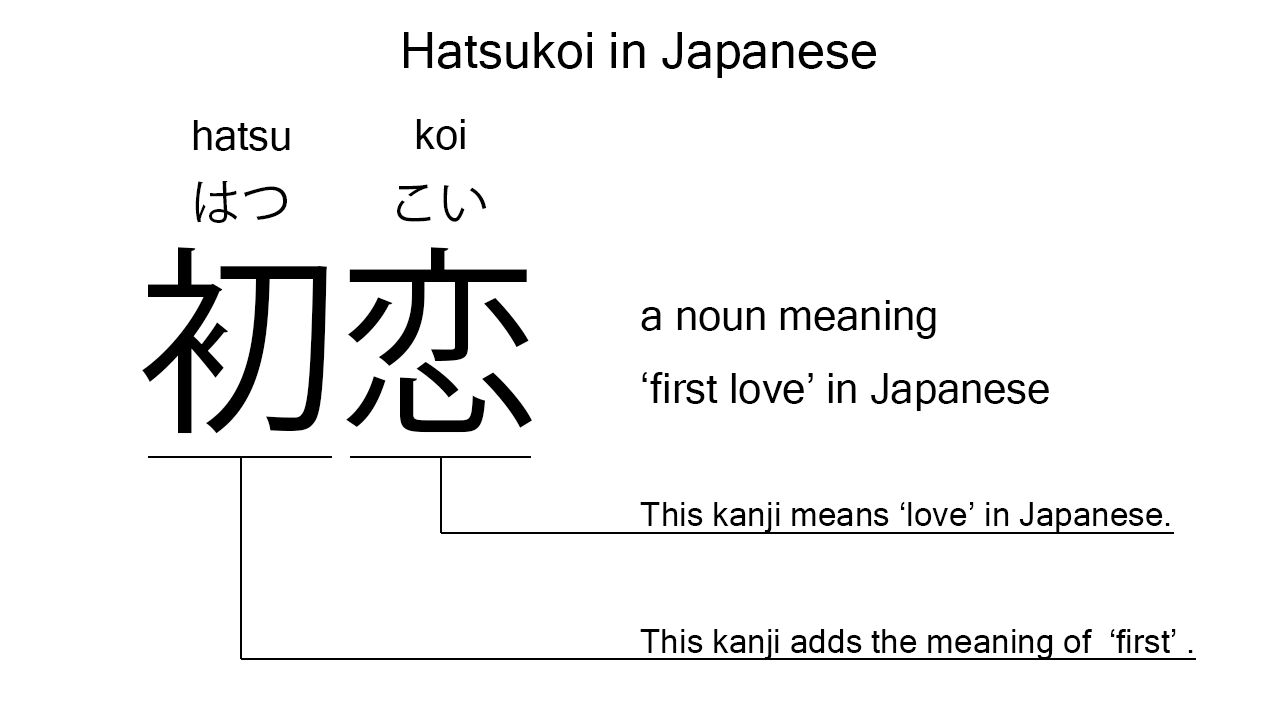What does “hatsukoi” mean in Japanese?
Native speakers use hatsukoi often to mean ‘first love’ in Japanese. Perhaps, some Japanese learners know this word as it is sometimes used in Japanese movies, songs, novels, manga, anime, and the like. In this blog post, however, I’m explaining this word in detail based on its kanji expression. And also, I’m explaining how to use it through example sentences. My explanations would help Japanese learners understand hatsukoi more clearly. Then, let’s get started!
Contents
Definition and meanings of “hatsukoi”
Let me start with the definition and meanings of hatsukoi.
- hatsukoi – 初恋 (はつこい) : a noun meaning ‘first love’ or ‘first feeling of love’ in Japanese.
Japanese native speakers use this noun to refer to the first person whom someone loves romantically. In addition, they often use this to refer to the feeling at the beginning of that romantic relationship.
The definition and meanings are not that difficult. To understand this noun more clearly, however, let me explain its kanji characters in detail, one by one.
Hatsukoi in kanji
The kanji expression of hatsukoi consists of the following two kanji characters:
- 初 : a kanji character often used as a prefix or suffix to add the meaning of ‘first’ in Japanese.
- 恋 : a kanji character used to mean ‘love’ in Japanese.
From these two kanji characters, we can understand that the formed noun literally means ‘first love’ in Japanese. This literal interpretation is very close to the actual meanings.

When we meet new kanji expressions, we should check their kanji characters in detail to understand their meanings clearly and deeply. In many cases, kanji characters tell us a lot about the meanings of the expressions they form. Actually, here, we could get the better understanding of hatsukoi through the detailed kanji check above.
So far, I’ve explained the definition and meanings of hatsukoi together with its kanji characters. Then, let me explain how to use it through the example sentences below.
How to say “first love” in Japanese
kanojo ga boku no hatsukoi deshi ta – 彼女が僕の初恋でした (かのじょがぼくのはつこいでした)
She was my first love.
Below are the new words used in the example sentence.
- kanojo – 彼女 (かのじょ) : a pronoun meaning ‘she’ in Japanese.
- ga – が : a case particle used to make the subject word or the object word in a sentence. In the example, this is used after kanojo to make the subject in the sentence.
- boku – 僕 (ぼく) : a pronoun meaning ‘I’ in Japanese. This is used mainly by boys and young males.
- no – の : a case particle used after a noun or pronoun to make its possessive case. In the example, this is used after boku to make its possessive case, boku no, which means ‘my’ in Japanese.
- deshi – でし : one conjugation of the auxiliary verb, desu, which is used after a noun or adjective to make it polite. In the example, it has been conjugated for the better connection with its following word.
- ta – た : an auxiliary verb used after a verb, adjective, or auxiliary verb to make its past tense form. In the example, this is used after deshi to make its past tense form, deshi ta.
This is a typical usage of hatsukoi. In this example, it works as the complement in the sentence.
Another example of “hatsukoi”
hatsukoi wa horonigakat ta yo – 初恋はほろ苦かったよ (はつこいはほろにがかったよ)
The first love was bittersweet.
Below are the new words used in the example sentence.
- wa – は : a binding particle working as a case marker or topic marker. In the example, this works after hatsukoi to make the subject in the sentence.
- horonigakat – ほろ苦かっ (ほろにがかっ) : one conjugation of the i-adjective, horonigai, which means ‘bittersweet’ in Japanese. In the example, it has been conjugated for the better connection with its following word.
- yo – よ : a sentence-ending particle used to state the fact or idea in a soft way. As the definition suggests, this is used at the end of the example sentence to state the speaker’s idea softly.
This is another example of hatsukoi. In this example, it works together with the binding particle, wa, to become the subject in the sentence. When we want to refer to the first person whom someone loves romantically or the very first feeling of that love in Japanese, hatsukoi is a very good option.
Summary
In this blog post, I’ve explained the definition and meanings of hatsukoi in detail based on its kanji expression. And also, I’ve explained how to use it through the example sentences. Let me summarize them as follows.
- hatsukoi – 初恋 (はつこい) : a noun meaning ‘first love’ or ‘first feeling of love’ in Japanese. These two kanji characters literally mean ‘first love’ in Japanese. This literal interpretation is very close to the actual meanings. Japanese native speakers use this noun to refer to the first person whom someone loves romantically. In addition, they often use this to refer to the feeling at the beginning of that romantic relationship.
Hope my explanations are understandable and helpful for Japanese learners.
Leave a Reply